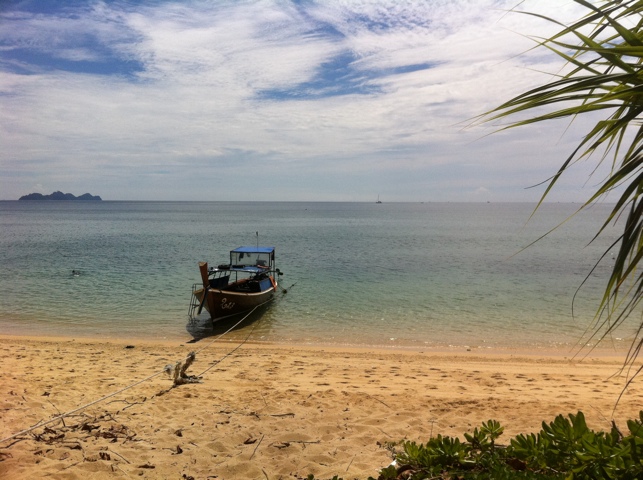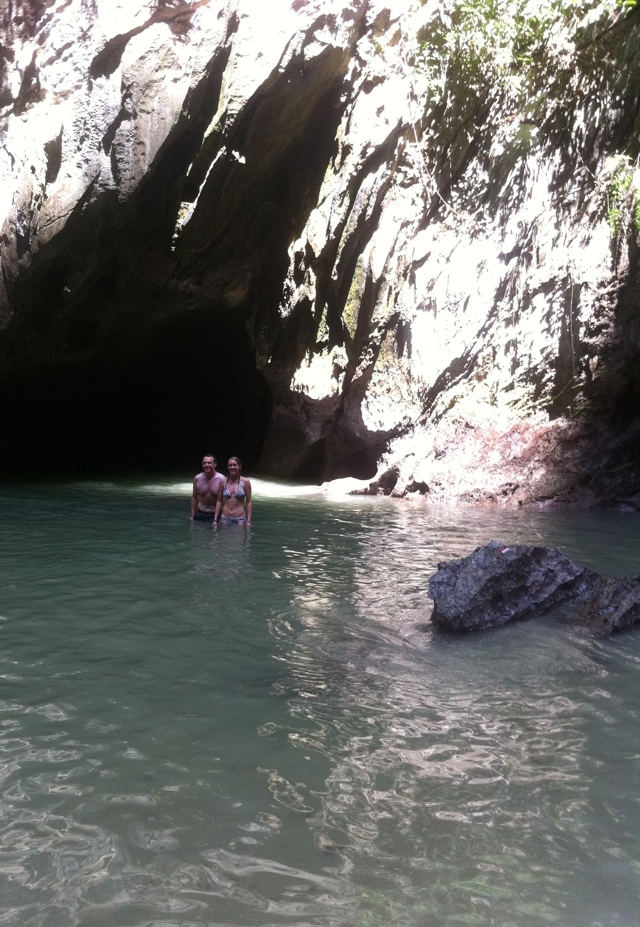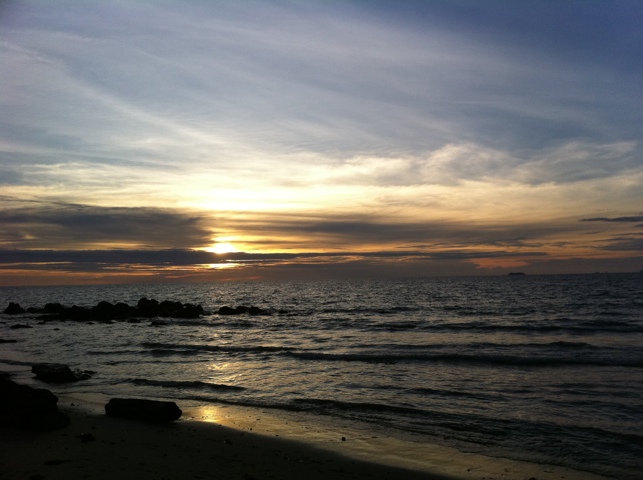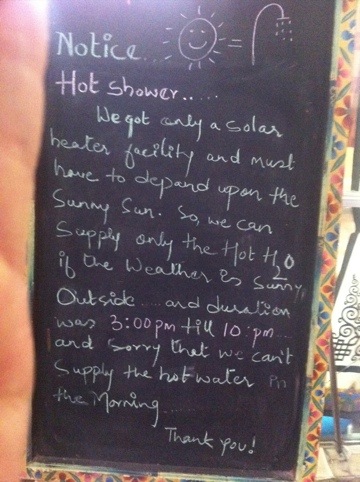Having taken the train from Bangkok and then a tedious day-long bus journey, we’re in Koh Lanta Noi, an island off the Andaman Coast of Thailand. This is the beach country, in both the book/film (set about 20km west of here) and the lying horizontal sense.
We’re here in ‘peak season’, a notch up from ‘high season’ that I didn’t know existed until we questioned the exorbitant prices of all the accommodation. Fortunately after a night in an expensive basic dorm (500 Bhat, or £10 each per night), we’re staying in a nice bungalow a short distance off the beach, which even has a fridge and kettle to tend to our breakfast and lunch needs. It’s lovely to be able to stop briefly again and soak up the sun, even if that means we’re both now sheltering in the shade after becoming slightly more red than golden brown this morning.
On our first day here, it rained pretty heavily in the afternoon. We saw the dark clouds sweeping in over the tree covered hills inland, and since we were on the beach, decided to head for the sea to see it through. I’ve heard people describe the sea as ‘boiling’ in a storm but never quite understood. Standing there as the heavens opened, it was more like the sea was carbonating around us, an effervescent bubbling of translucent blue. The tiny falling raindrops were themselves almost imperceptible and certainly invisible; far more significant were the upward rebounding splashes from the salty sea as each raindrop hit, their speed meaning that much more water leapt up than was coming down from the clouds. It was a strange taste sensation too – turn your head downwards for salt, and upwards for the sweetness of fresh water.
Yesterday, we went on a boat trip to go snorkelling and swimming at ‘four islands’, an hour south from here. I’ve never snorkelled before; it was fantastic to catch a glimpse of life beneath the waves, even if the coral reef where we were was sadly dead. It was one of those truly eye-opening occasions (albeit tempered by a face mask), with alarmingly spiky brown sea urchins nestled in the rocks beneath, and thousands of little fish swimming around, some solo and in fluorescent yellows and electric blue, others like tadpoles swimming in shoals in their hundreds around us. At one point, one of them had a nibble of my leg, but it seems it wasn’t a piraña, as I’m still here to write this! There were also jellyfish in a bewildering (and concerning) range of sizes. The first one we saw was football sized and a see-through shade of light blue. Having mastered our underwater signals, we both indicated we should avoid it (pointing at it with expressions of sheer horror on our faces), and later on, that there were actually quite a few around to be careful of (communicated by swimming quickly back to the boat and climbing out). With the sun shining through the surface creating shards of rippling bright light down to the sea floor, it was quite a spectacle as the jellyfish came into view through the clouds of dust. Some had a purple edge to their body, which was about an inch in diameter, with a long trail of tentacles behind. And then when you looked closer at the clouds of dust particles suspended in the water, you realised that many of the particles were actually also jellyfish, tiny creatures only a few millimetres long, in a swarm of thousands together. It was definitely time to get out, as a sting to my arm soon confirmed!
The day was also a chance to visit Emerald Cave. Jumping from our boat, we were led swimming by our guide into a pitch black cave that opens onto the ocean. Fortunately he had a torch that worked! After about 80m and a number of corners, we emerged onto a secret beach in the middle of the island, surrounded on all sides by high rocky cliffs and with just the watery tunnel as a way in. Fittingly for a secretive cave, this used to be used by pirates to stash their ill-gotten gains before they were sold on the mainland. Unfortunately we left our cutlasses, rum and even kazoos at home, so we just had to make do with a couple of photos and leaving our blog address scrawled in the sand. I’m not quite sure that these words match up to the treasure troves from previous visitors though!
Last night we watched the beautiful sunset sitting on the beach here, a fitting image for what’s soon approaching – the setting sun on the first part of our trip. We looked out at a picturesque scene filled with colours that echoed our travels so far: the white crests of waves like the snow of the Himalayas; the bright oranges of Buddhist monks; the deep blue sky of Rajasthan in India; the yellow sand of the dunes in the desert; and the peaceful lapping of the waters edge that we found throughout Laos and Cambodia. Appropriately, there were some dark rocks cutting through the surface, silhouetted poignantly against the reflections of the stunning sun – a metaphor perhaps for the half-hidden horrors lurking beneath the surface in Vietnam, or Laos, or Cambodia – or maybe just a reminder that shipwrecks can and do happen in the most idyllic of settings.
Even here in stunning Southern Thailand there are reminders of recent horrors – in this case, of the 2004 Tsunami which wrought destruction globally. Every few hundred metres along the road is a sign with directions for the evacuation route, and huge sirens stand tall on towers over the prominent beaches. Of course, this is what was required to ensure that all-important tourism returned to these islands after the deaths of holidaymakers; one can’t help but wonder if a system is quite so well established in the multitude of rural coastal communities where whole towns and villages were decimated by the destruction that day. And of course the tsunami was globally visible, played on the world’s TV screens via the camcorder scenes of destruction from beach resorts. The threat of climate change, which will affect many more lives if estimates are correct, is one for which the warning sirens started sounding many years ago, but where we all seem to still be on the beach, admiring the view while on our cheap flight holidays – and indeed our round-the-world trips.
Simon




